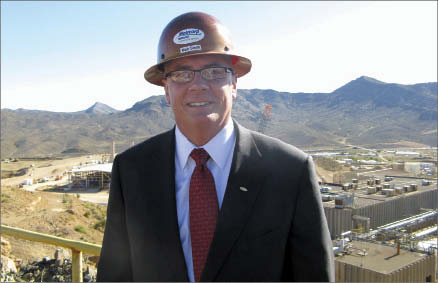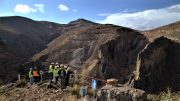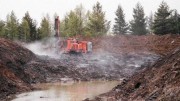In late October Molycorp (MCP-N) bused journalists from Fortune, Wired, Mother Jones and The Northern Miner, among others, down Interstate Highway 15 from Las Vegas to meet president and chief executive Mark Smith and tour the company’s Mountain Pass mine in California’s upper Mojave desert.
The media tour followed a presentation earlier that morning to analysts and a handful of state legislators that was timed to coincide with Molycorp’s announcement before markets opened that it would begin processing ore three months ahead of schedule, or by the end of 2012’s third quarter – a decision that would raise the company’s estimated production next year by 3,500 tonnes, to between 8,000 tonnes and 10,000 tonnes.
Molycorp told the visitors that to meet the earlier-than-expected production date it planned to start mining and stockpiling new ore the very next week. “The big orange ‘x’ in the lower right-hand corner of the pit marks the spot where we will start mining fresh ore,” Smith told the group, including a two-man South Korean television crew based in Los Angeles and a pair of photojournalists who had flown in all the way from Italy.
The accelerated start-up will cost Molycorp an additional US$114 million, including labour fees and contingency funds, and works out to 15% of the company’s initial construction costs of US$781 million. But the urgency of starting sooner rather than later seems almost palpable amongst management.
“There are huge price differentials between in-country Chinese rare earth products and export prices, and that is causing non-Chinese users of these materials to make a very, very difficult decision,” Smith says. “Do they want to keep their manufacturing facilities where they are, or do they want to move them to China to take advantage of lower prices . . . the economics are very overwhelming to move to China.” In July, Chinese export prices were 200% higher than Chinese domestic prices, according to Morgan Stanley.
“We want to let our customers know that we understand those issues and that we’re going to do everything in our power to make sure these supplies get online as fast as possible, and that we will be a very reliable and secure partner, which makes that decision a little easier,” Smith explains.
Molycorp – the largest producer of rare earth oxides outside China and the biggest in the western hemisphere – says it expects to produce rare earth oxides at its phase-one run rate of 19,050 tonnes per year by Sept. 30, 2012, and will be capable of a phase-one run rate of 40,000 tonnes per year as early as mid-2013, if customer demand warrants it.
A combination of higher ore grades of 8.24% – versus 6% at Bayan Obo in Inner Mongolia, China’s largest rare earth mine – proprietary production technology, a cogeneration power plant that keeps power costs at 3¢ per kilowatt hour and a new chemical recovery system that will use 25% to 33% fewer chemicals than in the past, means Molycorp can produce its rare earth oxides at less than half the average cost in China. The company estimates its rare earth production costs will come in at US$2.77 per kilogram, compared with China’s US$5.58 per kilogram. Smith and other industry experts also predict those costs could rise in China as Beijing clamps down on the industry with tighter environmental regulations.
The orebody is amenable to higher recovery, with concentrate grades of 68%. And access to infrastructure couldn’t be better. The deposit, 96 km southwest of Las Vegas and 341 km northeast of Los Angeles, sits less than half a kilometre from the highway with electricity running right to the property.
Molycorp’s game plan includes becoming the highest margin-capture rare earth company in the business by creating a vertically integrated operating platform that will eventually include making high-powered magnets.
“When we analyzed the supply chain for taking rare earth elements and turning them into rare earth permanent magnets, what we discovered was that in China today you will typically have a rare earth extraction or mining company that sells their concentrate to a different company that makes oxides, and then that company will sell their oxides to a different company that makes metals, and then that company who makes metals will sell its metal to a different company that makes alloys, and the alloy company will sell its alloys to a different company that makes magnets,” Smith recounts.
“So our thought was that if we are going to be the highest margin-capture rare earth company in the world, we are going to execute a plan that allows us to have capabilities in that entire supply chain. And from our best estimates, we think we can probably have margins that will be 56% better than any other rare earth company in the world.”
Reserves at Mountain Pass can be broken down into different rare earth elements. Cerium makes up 48.8% of the known deposit, lanthanum, 34%; samarium, 0.8%; praseodymium, 4.2%; neodymium, 11.7%; and others make up 0.5%.
Mountain Pass has total proven and probable reserves of 2.2 billion lbs. of rare earth oxides and total resources of 4.6 billion lbs. That equates to a mine life that exceeds thirty years.
“We do enough drilling so that we always have thirty years of mine life,” Smith says. “We haven’t found the bottom of the ore yet, and there are over twenty natural outcroppings on the property. We’ll be on this pit for a long time, but we’ll be on this property for a long, long time.”
Getting its Mojo back
Rare earth elements were first discovered at Mountain Pass in 1949. Between 1966 and 1985 the mine became the major supplier of rare earth materials in the world, and companies in the U.S. performed all stages of rare earth material processing.
China caught up in the mid-1980s, and by the mid-1990s had become the world’s biggest producer of rare earth oxides. At
the same time, Mountain Pass ran into difficulties. A series of waste water pipeline breaches at Mountain Pass ultimately shut down
its separation plant in 1998, and mining operations were suspended in 2002 when the tailings pond reached full capacity. At the height of production, Mountain Pass produced up to 850 gallons of salt water per minute, which was piped to off-site holding ponds where the water was evaporated.
The impact of the suspended operations resonated throughout the industry. In 2003 Magnequench, a neodymium-iron-boron (NdFeB) permanent-magnet producer, closed its plants in the U.S. and moved to China. Germany’s Vacuumschmelze, an NdFeB permanent-magnet producer, also shut down its operations in Elizabethtown, Kentucky. Two years later Hitachi Magnetics, an NdFeB permanent-magnet producer, turned out the lights at its production facility in Edmore, Mich.
Mountain Pass resumed operations at its separation plant in 2007, but by that time the playing field for the extraction and processing of rare earth elements had long since tilted in favour of China.
“The surprisingly rapid progression from self-sufficiency [in the U.S.] prior to the nineties, to nearly complete dependence on imports from a single country today [China] involves a number of factors,” the U.S. Geological Survey explained in a 2008 commentary on its website. “These include much lower labour and regulatory costs in China than in the U.S.; continued expansion of electronics and other manufacturing in Asia; the favourable number, size and heavy rare earth element content of Chinese deposits; and the ongoing environmental and regulatory problems at Mountain Pass.”
Today China is responsible for almost 100% of the world’s conversion of rare earth oxides to metals. It produces 80% of the world’s rare earth alloys and the same percent of rare earth magnets.
Ownership of Mountain Pass changed hands in 2008, and the new owners believe they can give China a run for its money – or at the very least, better diversify the global su
pply of rare earths and rare earth products. A private equity group including Resource Capital Funds, Pegasus Partners, Traxys and Goldman Sachs purchased Mountain Pass from Chevron in September 2008 for US$132.3 million. In July 2010 they completed an 28-million-share initial public offering at US$14 per share, raising US$380 million to fund the restart of the mine and modernize its processing facilities.
The private equity group convinced Smith, the former president and chief executive of Chevron Mining, to take the reins at Molycorp. As an environmental compliance lawyer, Smith had spent years remediating the environmental regulatory issues at Mountain Pass – first at Unocal, and later at Chevron. Chevron inherited Mountain Pass in its 2005 acquisition of Unocal.
“About fifteen years ago when Mountain Pass had some environmental issues out here, I was the attorney they got to come out and work on that, and try to recapture the trust and reputation of the company,” Smith told the group of journalists. “We’ll make sure under my watch that we’re going to do things right from an environmental point of view.”
For starters, he says, the mining and processing operation will use less than half the freshwater it did in the past. Processed waste water will be recycled, reducing demand for freshwater and eliminating the need for more than 120 acres of evaporation ponds. Salt water produced in the operation will be recycled and used as a feedstock to produce new chemical reagents in a continuous, closed recycling loop.
Instead of storing mine tailings and processing water behind a tailings dam, the improved operation will remove most of the water from the tailings; recycle the water; form tailings into a residue or paste; and deposit the tailings layer after layer in a huge tailings area measuring 90 acres. The company estimates it will take 30 years to fill the new tailings area. An on-site natural gas-fired combined heat and power plant will provide power and steam, increasing system efficiency and cutting production costs.
Management claims the previous mill and processing facility achieved recovery rates of just 50% to 55% of rare earths from the ore to solution. The new facility improves recovery rates, which will extend the life of the resource, Smith says. The new processes will also increase overall system efficiency and reduce air emissions – including carbon dioxide.
“We’ll need less than half the ore in the new process as compared with the old process, and that is a phenomenal achievement,” Smith says. “It saves a lot of production costs and lowers the footprint of the site. Everywhere we look it’s a win-win.”
The cost advantage at Mountain Pass is driven by higher-grade, attractive power costs and the recycling of key reagents, Paretosh Misra, an analyst at Morgan Stanley wrote in a research note on Oct. 21, “While historically reagents were the biggest variable cost exposure [about 65%], chloralkali and cogeneration plants make natural gas the main variable cost exposure.”
Misra has a 12-month target price on the stock of US$90 per share. At presstime Molycorp traded at US$28.65 per share, down from its 52-week high of US$79.16.
On the recycling front, Molycorp says it’s in discussions with potential partners to recycle magnets and phosphors and retrieve heavy rare earth elements. “Recycling has basically been zero in this industry for the sixty years we’ve been in it,” Smith says. “With prices where they are now, recycling is very attractive.” Molycorp is focusing its attention on the
recycling of compact fluorescent light bulbs, which are sources of yttrium, europium and terbium, as well as the recycling of magnets.
The company is also excited about a new deposit it believes it has found on its property.
“We have two very, very large containers that are full of data from the fifty-nine years of exploration history,” Smith explains. “We’ve now taken all of that data and put it into an electronic data system, and lo and behold . . . we ended up with four prospects at the top of our list, and we’re looking at them right now. Every one of those has rare earth oxide ore grades [greater than 4%], and a very heavy distribution of heavy rare earths. And all four can be processed here at Mountain Pass.”
The most promising of the four prospects is four miles from the mine site and contains high concentrations of heavy rare earths, such as terbium, dysprosium, europium and neodymium. “This is the highest concentration of terbium that we’ve seen in any deposit in the entire world,” Smith says of the new discovery. “This is very, very unique mineralization, and the testing we’ve done so far occurs over an area that is two miles long.”
Brian Chin, an analyst at Gabelli and Company in New York, argues that if you are going to invest in the rare earth industry, Molycorp is “the company you want to invest in.”
“There are a lot more speculative juniors in Canada and Australia that have deposits. In fact, rare earth deposits are all over the world, but they’re mostly very low grade and in remote locations,” he says. “Apart from Lynas (LYC-A) and Molycorp, there are a lot of junior exploration companies that have deposits that might be in production in 2015 or 2016. But at this point it’s hard to distinguish one from the other because most are still in the exploratory stage, and don’t even have feasibility studies.”
Re-establishing a supply chain in the U.S.
In an April 2010 briefing to the U.S. Congress, the Government Accountability Office (GAO) estimated that rebuilding a U.S. rare earth supply chain could take up to 15 years. The U.S. has the expertise, the GAO claims, but lacks the manufacturing assets and facilities to refine oxides to metals.
Molycorp is bent on changing that, and is picking up expertise to make its “mine-to-magnets” strategy a reality. In April it purchased Arizona-based Santoku America, one of the leading producers of high-purity rare earth alloys and metals outside of China. The all-cash deal worth US$17.5 million gives Molycorp the capability to start manufacturing and selling rare earth alloys for the production of NdFeB magnets that are used in electric and hybrid cars, advanced wind energy turbines and other high-tech electronics and applications, as well as samarium cobalt magnets used in the defense and other industries. SAI, just outside Phoenix, will change its name to Molycorp Metals and Alloys, and will be the first rare earth metal and alloy producer in North America that is not dependent on rare earth materials sourced from China.
The same month Molycorp took an 80% stake valued at US$89 million in Estonia-based AS Silmet, one of only two rare earth processing facilities in Europe. In October Molycorp purchased the remaining stake and now owns 100% of the company. The European facility will get some of its feed from Mountain Pass and will focus on producing rare earth oxides and metals, including didymium metal, a critical component in manufacturing NdFeB permanent magnets. Silmet also happens to be one of the world’s leading producers of pure niobium and tantalum metal, which broadens Molycorp’s manufacturing know-how beyond rare earths.
In March, Molycorp entered into a co-operative research and development agreement with the U.S. Department of Energy’s Ames Laboratory that will focus on developing new methods to create commercial-grade rare earth permanent magnets. More recently Molycorp invested US$35 million in Boulder Wind Power, a company in the U.S. that has designed a rare-earth-magnet-powered wind turbine generator that can produce electricity at the rate of 4¢ per kilowatt hour, and use
permanent rare earth magnets without dysprosium, a relatively scarce rare earth that is only produced in China.
And it has recruited Stan Trout, one of the world’s leading experts on the design and manufacture of permanent rare earth magnets. Before joining Molycorp, Trout ran Spontaneous Materials, a consultancy
for the industry, and prior to that had worked for Magnequench, one of the last companies to make NdFeB permanent rare earth magnets in the U.S.
Last month Molycorp opened an office in Tokyo to better serve its Japanese customers, which account for half of its sales.
Molycorp has had setbacks, too. In August a proposed partnership with Hitachi Metals to create a joint venture in the U.S. to manufacture NdFeB alloy and permanent magnets fell through when the two companies failed to reach an agreement on valuation. The joint venture would have provided Molycorp with access to the intellectual property needed to produce NdFeB magnet alloy and magnets on U.S. soil. Smith said in a press release at the time that Molycorp was in advanced discussions with other possible joint-venture partners.
But Jon Hykawy, a mining analyst at Byron Capital Markets, doubts that Molycorp will find a first-tier partner because he says it appears that Molycorp has been asking too much for their contribution to the joint venture. “They have yet to announce a magnet manufacturer, and if they’re just going to provide magnet alloys to the wider industry, their profitability drops dramatically,” he says.
Supply and demand
Molycorp paints a dim picture of supply fundamentals in the industry. Smith points out that demand has been 125,000 tonnes per year since 2010 and will grow to 255,000 tonnes per year by 2020. “The Chinese are exporting about twenty-one thousand to twenty-two thousand tonnes of rare earth materials for sale to the rest of the world this year, but the rest of the world needs about fifty-one thousand to fifty-two thousand tonnes of this material,” he says. “Molycorp is producing between five thousand and six thousand tonnes of this material this year, and there’s still a gap. If you’ve got that gap, you’re going to continue to have pricing pressure in the market. There are a lot of people out there that want these materials, and they simply aren’t available right now.”
Last year China’s export quotas for rare earths declined 40% year-on-year. They declined further this year based on a rare earth oxide-equivalent basis, according to Molycorp, citing independent market analyst Dudley Kingsnorth of Industrial Minerals Company of Australia. And a crackdown on illegal Chinese exports could reduce global supply, the company warns.
From October 2009 to halfway through this year, pricing for all the rare earths increased by an average of 1500%, Smith says.
But prices have fallen significantly since then. Cerium, for example, one of the most abundant rare earth minerals and used primarily in glass polishing, soared from US$4 per kilogram in 2009 to US$157 per kilogram in July, but has fallen to around US$55 per kilogram more recently. Prices for lanthanum oxide rose from US$5 per kilogram in 2010 to US$140 per kilogram in July 2011, but dropped to US$62 per kilogram in November.
Some investors and analysts are concerned about the risk to rare earth prices once non-Chinese supply starts coming on stream in a meaningful way in 2012. Bryon Capital Markets’ Hykaway, who has a 12-month target price on Molycorp of US$37.50 per share, argues that the company’s value is “baked in,” and explains that that is not because rare earth prices have been falling.
“We think the biggest problem is going to be what is going to happen to rare earth prices in 2013 and 2014, when Lynas [Mount Weld] is in production,” he says. “We’re going to be swimming in the stuff [lanthanum and cerium] and their prices are going to collapse. Our long-term view is that we think they’re going to go down to the low single digits for lanthanum and cerium, and that suggests Molycorp won’t be as profitable as they say they’re going to be.”
When asked whether he worries about a surplus of rare earth element material flooding the market once Lynas’ Mount Weld comes online, Smith shakes his head.
“I think what people do is that they mix up their years and their math. When Mountain Pass comes online, and if Lynas comes online, what people like to do is add it to what the Chinese supply may be in 2015, and then they just compare it with demand today. They forget that world demand is growing. We just do not see any way that supply and demand can come into equilibrium between now and 2016.”
As for cerium, one of the most common of the rare earth elements and one that makes up nearly half of all rare earth elements at the Mountain Pass deposit, the company has designed a new water-treatment technology called Xsorbx that it believes will mop up any excess cerium it can’t sell on the market.
The company has started selling Xsorbx for commercial use in waste water, industrial processes, recreational pool and spa, and other water-treatment markets.
Hykaway of Bryon Capital Markets, however, is skeptical of Xsorbx, arguing that while cerium does a “reasonable job” of sequestering certain toxins in water, it is “not a novel concept,” and will have to compete against a “tried-and-true” product called ferric chloride, which he argues does much the same thing as Xsorbx. “[Molycorp] has noted that the cost of cerium would have to fall to less than ten dollars per kilogram to make Xsorbx cost competitive with ferric chloride,” Hykaway says. “So they must agree that some things that Xsorbx does can be replicated.”
Hykaway adds that ferric chloride has been used for years. There are no patents that apply to it, and companies can buy it from a wide variety of suppliers and not get squeezed. “Their alternative is to look at Xsorbx. It comes from one supplier, so if they have an issue with their plant or their patents it could start to be a problem . . . it’s an unknown in the water-treatment industry, and the water-treatment industry is very, very conservative.”
John Burba, Molycorp’s chief technology officer and executive vice-president, sees it differently. “It’s not correct to say that there’s nothing novel with Xsorbx,” he said in a telephone interview. “We’ve found uses for cerium chloride that are different than what is out there . . . we have broadened cerium claims well beyond phosphate removal, so we’re looking at phosphates – we’re looking for pesticides, arsenic, chromium, lead and things of that nature – these are novel uses for rare earths.”
Jim Sims, Molycorp’s vice-president of corporate communications, adds that “more than eighty percent of water-treatment facilities in the U.S. cannot take out the amount of arsenic they need to. In the industrial waste water-treatment market alone, if we sold our cerium to only three large copper mines, we would consume all the cerium we can produce at our phase-one production rate.”
In terms of U.S. prices for Xsorbx, Misra of Morgan Stanley wrote in an October research note that “cerium in Xsorbx sold to copper smelting applications can get around nine dollars per kilogram, municipal water treatment can get twelve dollars per kilogram, recreational water, thirty-five dollars per kilogram, and drinking water even higher. We use sixteen dollars per kilogram cerium in our forty-seven-dollar per kilogram, blended average price deck.”






Be the first to comment on "Molycorp’s Mountain Pass: A made-in-America solution"